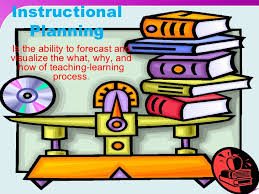
Performance Standard 2: Instructional Planning:
The teacher candidate plans using state and local school district curricula and standards, effective strategies, resources, and data to address the needs of all students.
|
Performance Indicators at the Level III Level
|
|
Performance Rubrics
2.1 Analyzes and uses student learning data to inform planning.
2.2 Develops plans that are clear, logical, sequential, and integrated across the curriculum (e.g., long-term goals, lesson plans, and syllabi).
2.3 Plans instruction effectively for content mastery, pacing, and transitions.
2.4 Plans for instruction to meet the needs of all students.
2.5 Aligns and connects lesson objectives to state and local school district curricula and standards, and student learning needs.
2.6 Develops appropriate course, unit, and daily plans, and is able to adapt plans when needed.
|
|
Level I
|
Level II
|
Level III
|
Level IV
|
|
The teacher does not plan, or plans without adequately using state and local school district curricula and standards, or without using effective strategies, resources, or data to meet the needs of all students.
|
The teacher candidate inconsistently uses state and local school district curricula and standards, or inconsistently uses effective strategies, resources, or data in planning to meet the needs of all students.
|
The teacher candidate consistently plans using state and local school district curricula and standards, effective strategies, resources, and data to address the differentiated needs of all students.
|
The teacher candidate continually seeks and uses multiple data and real world resources to plan differentiated instruction to meet the individual student needs and interests in order to promote student accountability and engagement. (Teacher candidates rated as Exemplary continually seek ways to serve as role models or teacher leaders. This level is not intended for formative assessments of teacher candidates and may only be used in the summative assessment with proper documentation of the teacher candidate’s consistent performance at this level.)
|
|
Examples of Evidence/Artifacts to demonstrate performance on this standard:
|
- Analyzes and uses student learning data to inform planning
- Develops plans that are clear, logical, and sequential
- Aligns lesson objectives and assessments to state and local standards
- Considers pacing and transitions in planning
- Plans for instruction to meet the needs of all students
- Integrates other content areas when appropriate
- Use materials from a wide variety of resources for lesson planning
- Determine available technology resources and integrate technology into instruction when it is value-added.
|
|
What it is:
|
What it isn't:
|
- Evaluating the quality of available resources when designing a unit or lesson.
- Using criteria such as appropriateness for grade level, alignment to national, state, or local standards, accuracy of information, the time allowed for the lesson or unit, and the learning benefits that come from using the resource.
- Maximizing the instructional benefits of resources while minimizing time allocated to less relevant or unnecessary material.
- Asking key questions for effective instructional planning: 1) What should be taught? 2) How should it be taught? 3) How should instruction and student learning be assessed?
- Planning not only what to teach, but also more importantly, planning for whom are going to teach.
- Creating adaptive learning strategies that diagnose student learning needs on specific learning areas, developing learning activities that conform to the evolving skill level of the student, and adjusting time/pace on a content area according to student performance.
- Scheduling and rescheduling the learning progress, with flexible incorporation of additional practice and review.
- Planning a blend of whole-group, small-group, and individualized instruction.
- Seeing a logical sequence and purpose for most instruction and activities.
- Describing a variety of activities the teacher uses to engage students in meeting specific standards.
- Learn from assessment tasks that clearly measure progress and mastery of standards.
- Engage in learning activities that lead to achieving and exceeding standards. Understand teacher’s reasons behind activities, organization of learning, and assessments.
- Understanding the connections between CCGPS/GPS and classroom assessments.
- Demonstrating the use of higher-order thinking skills in plans and assessments.
Exhibiting these types of behaviors while making planning decisions:
- Constructing a blueprint of how to address the curriculum during the instructional time
- Using student assessment data to plan what goals and objectives to address
- Planning for the context of the lesson to help students relate, organize, and make knowledge become a part of students’ long-term memory
- Sequencing material to promote student’s cognitive and developmental growth
- Using knowledge of available resources to determine what resources they need to acquire or develop
- Taking into account the abilities of their students and the students’ strengths and weaknesses as well as their interest level
|
- Textbook driven
- One size fits all
- Believing that learning is a mechanical process of information being transferred from textbooks to students who acquire it through listening, reading, and memorization.
- Acting out scripts written by the publishers of textbooks and tests.
|
|
Sample Questions for Conferencing:
|
- What process or rationale do you use in selecting standards for lessons or units?
- How do you engage students in planning, learning, and assessing their learning?
- How do you plan for assessment of student progress and mastery of standards?
- How do you ensure alignment of standard, learning objective and assessments?
- How do you plan for the different needs of your students?
|
Reference and for more information visit
https://www.gadoe.org/School-Improvement/Teacher-and-Leader-Effectiveness/Documents/TKES%20Fact%20%20Sheets%207-11-2012.pdf
